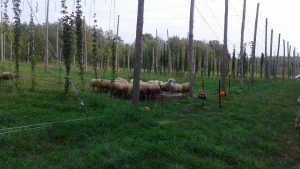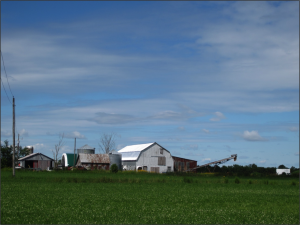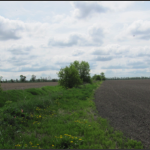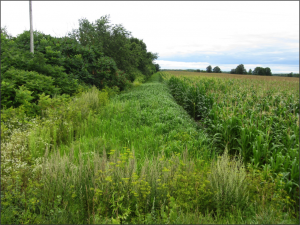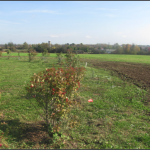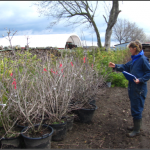A Case Study
August 2015
Compiled by Lauren Allen, based on participant observation and interviews with:
Bryan Gilvesy, Interim Executive Director, ALUS Canada
Brendan Jacobs, Program Coordinator, Ontario East ALUS
Jacqueline Pemberton, Ontario East ALUS Farmer
ON East ALUS – Case Study
Download as a pdf [6 MB]
This work was made possible through generous funding from the Social Sciences and Humanities Research Council of Canada.
Suggested citation:
Allen, L. 2015. Ontario East Alternative Land Use Services Program: A Case Study. Centre for Sustainable Food Systems, Wilfrid Laurier University.
We’re finding market value, and passing that market value through to farmers for the production of ecosystem services. In other words, the value of that tree as it grows, if the tree is a metaphor. And the upshot is, we’ve turned out to value nature.
Executive Summary
Alternative Land Use Services (ALUS) is a non-profit program offering an innovative model for environmental conservation, by providing farmers with financial incentives for the ecological goods and services produced on their land. ALUS pays farmers to retire land from agricultural production, and retain or convert it to a natural state, such as a grassland, wetland, or riparian buffer. These actions result in widespread benefits, including carbon sequestration, improvements in water quality, and increased habitat for fish, wildlife, and pollinators.
In 2012, ALUS launched a pilot program in Eastern Ontario, with the aim of implementing between three and six projects over the course of the three-year pilot. In 2015, as the pilot project draws to a close, the program has far exceeded its original goal, with twenty-one projects implemented on fourteen separate farms. Much of the success of the ALUS program can be attributed to the organization’s commitment to following a set of guiding principles, rather than fixed rules. These principles, which include being community-developed, farmer-delivered, voluntary, and market-driven, have allowed ALUS to adapt to the unique needs and visions of the communities within which it operates.
While ALUS is an environmental program, it also has important economic and social benefits. By assigning an economic value to ecological goods and services produced on farms, the program helps to fill a gap in the Canadian economy. The program also helps to build ecological and economic resilience in communities, while building networks and bridging divides among individuals and organizations from a variety of sectors. These qualities help contribute to both increased food security and community development.
Project Overview
Alternative Land Use Services (ALUS) is a community-developed, farmer-delivered non-profit program that provides support to farmers and ranchers to enhance and maintain ecological goods and services (or “nature’s benefits”) on their property. By recognizing the key role that farmers and ranchers play as stewards of the land, and compensating them for these services, ALUS offers a new model for ecological restoration and conservation. The vision of ALUS is to “create a healthy landscape that sustains agriculture, wildlife, and natural spaces for all Canadians” (ALUS, 2015). In addition to being community-developed and farmer-led and delivered, ALUS follows several other guiding principles: it is targeted, market-driven, voluntary, integrated, accountable, and science-based (see Figure 1).
| ALUS Principles
Community-developed – Developed by local communities to be flexible and respect local agricultural and environmental priorities. Farmer-delivered – Farmers and ranchers are in the best position to deliver nature’s benefits on their land. Targeted – Select marginal or ecologically sensitive parcels of land are managed in a different manner to produce nature’s benefits. Market Driven – Benefits from nature produced by project activities have economic value. Voluntary – Farmers and ranchers choose to participate and have flexible agreements that suit their operation. Integrated – Delivery will complement existing conservation programs including federal and provincial government policy frameworks. Accountable – Projects are independently monitored and audited. Science-based – Social, economic and environmental sciences guide program development and implementation. |
Figure 1 – Guiding principles of ALUS. From http://www.alus.ca/vision/
ALUS began in Blanshard, Manitoba in 2006, under the leadership of Keystone Agricultural Producers—Manitoba’s largest farm organization—and the Delta Waterfowl Foundation, a habitat conservation organization dedicated to waterfowl and waterfowl hunting. The program was founded based on the recognition that farmers should receive financial compensation for the wide-ranging ecological goods and services that they provide in caring for their land. Benefits of ecological stewardship practices on farmland include carbon sequestering; protecting fish, wildlife, and pollinator habitat; improving flood and erosion control; and contributing to water purification, soil formation, and nutrient cycling. Since 2006, ALUS has spread to twelve agricultural communities across the country, and now operates in Ontario, Prince Edward Island, Alberta, and Saskatchewan, as well as Manitoba.
ALUS operates by working with farmers to retire lands considered marginal, or inefficient to farm, from agricultural production. In many cases these areas, such as slopes along watercourses, are also more environmentally sensitive. Farmers are paid to allow the retired areas to naturalize, and for implementing projects, such as wetlands, grasslands, riparian areas, and tree plantings, on the land. Such actions can increase biodiversity, create habitat, and contribute to cleaner air and water, thereby contributing to a more sustainable model for agriculture.
Ontario East ALUS
(Although locally the program is known as Ontario East ALUS, provincially and nationally the program is referred to as “ALUS – Ontario East”.)
In 2012, as part of an initiative to expand ALUS to more agricultural communities in Canada, ALUS launched three, three-year pilot projects in the Ontario communities of Bayham, Grey and Bruce Counties, and Ontario East. Ontario East ALUS operates on a watershed basis, working closely with the two local Conservation Authorities: the Raisin Region Conservation Authority (RRCA) and South Nation Conservation (SNC), as well as the Ontario Woodlot Association (Stormont, Dundas and Glengarry chapter). The geographic area covered by Ontario East ALUS corresponds with the boundaries of the Raisin – South Nation Source Water Protection Region, and includes the counties of Prescott-Russell and Stormont, Dundas & Glengarry, as well as sections of the city of Ottawa and Grenville County. As the end of 2015 approaches—marking the end of the pilot phase of the program—Ontario East ALUS has worked with farmers to retire and naturalize approximately 70 acres of agricultural land.
The roots of Ontario East ALUS can be linked to a now defunct RRCA tributary restoration program that worked with landowners in the Raisin Region to implement best management practices on their properties. When the government funding for this program was cut, there were no programs left in the area to continue this type of work. This gap provided the impetus to establish the Ontario East ALUS program in the Raisin Region, and expand it to the adjacent South Nation Watershed, which experiences similar land management issues related to farming and forestry practices.
Geographical Context
Collectively, the United Counties of Stormont, Dundas and Glengarry, combined with Prescott-Russell, had a population of nearly 200,000 in 2006 (EOWC, 2007). The counties are located in the easternmost region of Ontario, and are bounded by the province of Quebec to the east, the Ottawa River to the North, and the St. Lawrence River to the south. Agriculture, particularly corn production, is a major land use in the region, and in recent years, forested areas have been increasingly converted to agricultural production in response to a diminishing forestry industry.
PROJECT RESOURCES
Human Resources
Ontario East ALUS has one permanent employee, Brendan Jacobs. Brendan works part-time as the Program Coordinator of Ontario East ALUS, and part-time as the Fish & Wildlife Biologist for the Raisin Region Conservation Authority. Brendan began working with Ontario East ALUS in 2012, when the pilot program was launched. As the ALUS program continues to expand and receive more funding nationally, there may be potential for the part-time pilot Program Coordinator positions to transition into full-time positions.
In addition to Brendan, students are usually hired in the summer months, and divide their time between the RRCA and Ontario East ALUS. Through the RRCA, Ontario East ALUS also has access to a database of volunteers, who can be called on to help out with labour-intensive projects such as tree planting. In addition, co-op students from nearby universities and colleges often complete their work placements at the RRCA, providing additional support for the Ontario East ALUS program.
Ontario East ALUS, like the other regional branches of the program, is governed by a Partnership Advisory Committee. This community-based, 15-person committee is comprised of seven farming members and eight advisory members from partner agencies. Advisory members include representatives from the RRCA, South Nation Conservation, the Ontario Woodlot Association, Ontario Nature, Delta Waterfowl, and ALUS – Ontario. Only the farming members of the committee have voting privileges, while the representatives from partner agencies provide advice and guidance related to project implementation and program development.
Physical Infrastructure
Ontario East ALUS operates out of the Raisin Region Conservation Authority office, located in Cornwall, Ontario. This partnership has been very beneficial for Ontario East ALUS for a number of reasons. Nearly all the organization’s needs for office space, vehicles, and office and field equipment are met through loaning or renting arrangements with either the RRCA or South Nation Conservation. Ontario East ALUS pays mileage to the RRCA for the use of their vehicles, as well as a program rental fee that covers accounting services, the ability to use office equipment, and workshop, lab, and office space. In terms of physical infrastructure, Ontario East ALUS owns very little itself, aside from a few pieces of specialized equipment (such as a seeder recently purchased by the organization). By making use of the RRCA’s existing resources, Ontario East ALUS has been able to allocate more of their resources into project implementation, rather than overhead costs.
Financial Resources
Ontario East ALUS, like its national and provincial counterparts, relies on grants from foundations, the government, and individuals. Some grants are applied for at a national or provincial level and then allocated among regions, while local grants are applied for independently by Ontario East ALUS. Currently, the majority of funding for the program comes from the W. Garfield Weston Foundation and the Ontario Trillium Foundation. Ontario Nature, as a partner of the ALUS program, applied to the Ontario Trillium Foundation on behalf of ALUS. The support of these foundations was critical as seed funding to launch the three-year pilot program of which Ontario East ALUS is a part. The W. Garfield Weston Foundation is a lead partner in the ALUS program, and provides funding towards project implementation and annual payments to farmers, while the Ontario Trillium Foundation provides funding related to salaries, and—to a lesser extent—communications and travel costs.
Additional funding comes from the Ontario Ministry of Natural Resources & Forestry, the Ontario Wildlife Federation, Environment Canada, and the Ontario Woodlot Association (Stormont, Dundas and Glengarry chapter). At a local level, Ontario East ALUS has received funding from the Clean Water Committee for South Nation, the Eastern Ontario Water Resources Committee, and Ducks Unlimited.
Ontario East ALUS also receives funding through personal donations and farmer contributions, which may be either cash or in-kind. In some cases, ALUS farmers provide cash towards project implementation, such as funds towards tree planting, wetland creation, or fencing to keep livestock out of watercourses. In other cases, farmers provide in-kind services, such as site preparation for tree and shrub planting, or mowing recent planting sites to help manage weeds and encourage plant establishment.
Community Resources
Non-Profit Organizations
Ontario East ALUS has strong ties to their direct local partners, namely the Raisin Region Conservation Authority, South Nation Conservation, and the Ontario Woodlot Association. Representatives of the two Conservation Authorities and the Ontario Woodlot Association sit as advisory members on the Ontario East ALUS Partnership Advisory Council. At a provincial and national scale, Delta Waterfowl, Ontario Nature, Ducks Unlimited Canada, and other environmental NGOs are also close partners. In addition to providing funding, Ducks Unlimited Canada provides advice on restoration projects. The Ontario Soil and Crop Improvement Association, a non-profit farm organization, is also supportive of the project.
Ontario East ALUS is also supported by two environmental organizations based out of Cornwall: the St. Lawrence River Restoration Council (SLRRC) and the St. Lawrence River Institute of Environmental Sciences (SLRIES). The SLRRC was formed to address environmental concerns related to the St. Lawrence River Area of Concern at Cornwall, and is comprised of local representatives from environmental organizations, the general public, industry, municipalities, the St. Lawrence River Institute of Environmental Sciences, Conservation Authorities, government, and Aboriginal groups. SLRIES is a non-profit research institution; while they do not sit on Ontario East ALUS’s Partnership Advisory Council, they are available to provide advice, research ideas, and water quality testing.
Government
While governments at various levels provide funding for Ontario East ALUS and are supportive of the program, the program operates independently of the government. This relationship is by design, since ALUS is first and foremost a community-developed organization. Further, a distrust of government programs exists in Eastern Ontario, largely as a result of historical environmental legislation having a negative effect on landowners. In the past, farmers and other landowners felt they were not adequately consulted prior to the implementation of environmental legislation that affected their land use practices. As a result, Ontario East ALUS is mindful to distinguish itself as a community-based program.
Individuals
Individual connections form the core of the work undertaken by Ontario East ALUS. The program is currently working with 14 farmers in the region. Participation in the ALUS program is at the farmer’s discretion, and interested farmers work with ALUS to determine what areas of their farm are best suited for the program, and what type of project is most suitable. Project types are flexible, but may include hedgerows or windbreaks, wetland creation or enhancement, tree planting, buffer zones along watercourses, or habitat improvement structures. Participating farmers sign renewable Conservation Agreements with ALUS, which are generally 3-5 years in length, but can be terminated by the farmer at any time. Farmers then receive annual payments based on the acreage of land they have retired, according to the fair market value for marginal farmland. In Ontario East, annual payment rates are $100 per acre. In order to be eligible for the program, farmers must have a valid Farm Business Registration Number, and farmers are allowed to enrol a maximum of 20% of their workable farmland in the ALUS program.
Buffer along agricultural drain, immediately following planting (left), and after vegetation has become established (right). Photographs courtesy of Ontario East ALUS.
The ALUS Model
We’re finding market value, and passing that market value through to farmers for the production of ecosystem services. In other words, the value of that tree as it grows, if the tree is a metaphor. And the upshot is, we’ve turned out to value nature. If buyers and sellers are both valuing something, than that is the big, big, big win here. — Bryan Gilvesy
While the ALUS model of paying farmers for the ecosystem services they provide seems simple, it is nevertheless innovative. ALUS has found a way to increase ecological benefits to a community, while also bringing economic benefits to farmers. While the multiple values of ecological goods and services have been acknowledged by governments, under the dominant economic model, nature is only assigned a monetary value when it is extracted. By assigning a similar monetary value to ecosystem goods and services, ALUS helps to fill a gap in the Canadian economic system. That is, the program not only recognizes the important role that farmers play as stewards of the land, but also acknowledges that since these services are for the greater public good, farmers should be compensated financially.
Farmers are motivated to participate in the ALUS program for a variety of reasons. Many farmers have a strong land ethic, and are engaged in environmentally beneficial stewardship practices voluntarily, so participation in the program allows them to gain additional income for something that they are already doing. Other farmers are incented to participate by the annual payments, and may also be swayed by a recognition of the indirect economic benefits that ALUS participation can bring (as will be discussed in the following section).
One of the key implications of the ALUS principles of being community-developed and farmer-delivered is that flexibility is inherent in the design of the program. This has allowed the program to adapt to the specific needs and desires of the communities within which it operates, to pursue creative solutions and, ultimately, to experience a high degree of acceptance within local communities. The program also contributes to making communities more resilient, increasing prosperity and social capital, bridging divides in communities, and fostering innovative solutions to ecological, social, and economic issues.
Building Adaptive Capacity
Economic Resilience
Instead of being paid to grow corn, or beef, or soy, they’re being paid to grow a wetland, or a buffer, or trees — Brendan Jacobs
As discussed in the previous section, farmers receive direct economic benefits based on the acreage of land that they have enrolled in the program. This income is not intended to be of prime importance to the farm; rather, it provides some incentive to participate, and complements additional farm income. In some cases, depending on factors such as the agricultural potential of the land retired, farmers may receive less income from ALUS payments than if they retained the land in production. However, since the land enrolled tends to be marginal, by retiring these lands from production, farmers may avoid costs associated with farming marginal lands, such as decreased yields in wet areas, or machinery breaking when operating on rocky soils.
Participation in the ALUS program also has the potential to provide a number of secondary economic benefits to farmers. Perhaps most significantly, by demonstrating their commitment to agricultural practices that benefit the local environment, ALUS farmers may gain increased access to the local food marketplace, and to consumers who want assurance that their food was grown in a sustainable manner. This comes with the potential to command higher prices for products grown on ALUS farms. While the Ontario East ALUS brand may not be sufficiently recognized in the local community yet for this to happen, ALUS farmers in other regions have benefited from these secondary economic impacts.
Other, perhaps less visible, economic benefits are also possible. Many of the native shrubs or trees that are planted to create hedgerows, windbreaks, or buffer strips produce edible fruit or nuts, which farmers can use for personal consumption, or as a small-scale income generating opportunity (although it should be noted that this is not a main objective of the ALUS program). Ecological agricultural practices can also have cost-savings benefits. For example, by increasing native pollinators on farms, farmers can potentially avoid having to rent honeybee pollinators. Additionally, creating wildlife habitat adjacent to agricultural fields contributes to integrated pest management, by providing habitat for insects, birds, and other animals that prey on agricultural pests, thereby potentially reducing the need for pesticides.
Food System Resilience
Involvement in ALUS “helps farmers get more connected back to working with nature on their farms, and building more resilient farms” — Bryan Gilvesy
Wetlands, healthy riparian areas, and tree planting can help to reduce bank erosion, retain water in the ground during periods of high rainfall, and release water slowly during dry periods. This can make farms more resilient to climate change and severe storms. Enhancing the natural environment and local watershed health also has a number of effects that benefits the food system indirectly. These include encouraging native pollinators, improving water quality, and reducing dependence on pesticides and herbicides, all of which can contribute to a more sustainable food system. By helping to make farms more resilient, ALUS is also contributing to greater resilience in the food system. Additionally, by broadening the networks of people that farmers have access to, ALUS helps connect farmers more strongly within their communities, which can lead to a better understanding of the needs of their communities, contributing to more secure food systems.
Ecological Resilience
The ability of ALUS to provide ecological benefits and help communities cope with environmental change are perhaps the most readily apparent impacts of the program. In Eastern Ontario, ALUS operates on a watershed-level scale. Improving the health of the local watershed has wide-ranging benefits for the greater community. Planting hedgerows or windbreaks has multiple environmental benefits, including habitat creation, reduced drift of sprays, and carbon sequestration. Creating vegetated buffer zones and keeping livestock away from watercourses can help reduce erosion and improve water quality, while also cooling the water, which in turn creates improved fish habitat. Wetland creation or enhancement projects help to filter water, create habitat, reduce peak flows during heavy rains, and retain water within the landscape. These water control benefits can help the local community cope in times of drought as well as during floods.
Grassy setback between existing hedgerow and agricultural field.
In addition to the types of projects mentioned above, other forms of habitat creation are often integrated as part of larger-scale projects. For example, substrate to encourage turtle nesting and turtle basking platforms can be integrated into suitable wetland projects. Nest boxes or other structures to encourage bird life can also be incorporated into larger projects, as can nesting cavities for native bees. While the environmental benefits of ALUS may seem small when considered on the basis of an individual farm, the collective benefits of many projects can contribute to the ecological health and resilience of the wider community. In areas such as Eastern Ontario, where agriculture is a major land use, the potential ecological benefits of the program are significant.
Increasing Prosperity
In addition to the direct and indirect economic benefits accrued by ALUS farmers and ranchers, the program supports local economic development in other ways. In Norfolk County, Ontario, for example (home to the longest continuously-running ALUS program in Canada), ALUS currently brings about $1.5 million dollars into the local economy through job creation and project implementation. As ALUS continues to expand its scale of operations to additional agricultural communities in Canada, these local economic benefits will spread. This economic development opportunity is exciting not only because it benefits local environments as well as economies, but also because ALUS operates in rural areas, which often experience struggling economies and low levels of job creation.
The community-driven ALUS principle helps ensure the program does not hinder local economic development. Since ALUS is developed by and for the community, it is unlikely the program would support activities that would have a negative impact on the local economy. However, as a further precaution, farmers cannot enrol more than 20% of their farmland in the program. This restriction prevents farmers from retiring their entire farm, while also minimizing the likelihood that prime agricultural farmland is taken out of production. Instead, farmers generally take marginal farmland, such as edges, slopes, or rocky or wet areas, out of production. The flexible nature of ALUS also helps to ensure that the economic development of the farming community is not hindered. If ALUS farmers decide to change from one type of operation to another, they can decide at any time to withdraw from the program — although if they withdraw within a very short time of the project being implemented, they may be required to repay some costs associated with the materials that were put into the project.
Increasing Social Capital
I think what ALUS does for local communities is it creates a level of engagement around the environment that’s not been there before. And this engagement leads to subtle cultural shifts, subtle identity shifts. I think it really helps create pride of place, it helps people describe who they are and what their foodshed looks like — Bryan Gilvesy
Creating Networks
Through creating networking opportunities, the ALUS program builds social capital in the communities in which it operates. Bryan Gilvesy, an ALUS farmer who recently became Interim Executive Director of the national ALUS program, provides an example of how extensive the relationship-building opportunities can be:
My relationship began like this: first I became an ALUS farmer, and then I became named a Toronto Food Policy Council Local Food Hero… and the award drags me to Toronto, somewhere where I am loathe to go, at the time. And now I’m in Toronto weekly, I have many accounts in Toronto, I have Toronto visitors to my farm. The relationships are in the hundreds that I’ve established. And I still remember the first time I went in to Toronto to collect that award, my wife and I were scared blind… ALUS has led us down a path of relationships that have improved our lives, and [that] of the local community around us.
Through his involvement with the ALUS program, Bryan Gilvesy has made connections with individuals, businesses, government, and members of the environmental and philanthropic communities. While not all ALUS farmers form such extensive networks, many develop new relationships on a smaller-scale as a result of their involvement in the program. An Ontario East ALUS farmer, Jacqueline Pemberton, who is also actively involved with several farming organizations and clean water initiatives in Eastern Ontario, has been able to utilize existing networks and form new relationships through her involvement with ALUS, through which she shares information on the ALUS program with the local farming community.
Building Knowledge
Once something is learned, you share it, right? So as soon as I know something, then somebody else is going to know it, too — Jacqueline Pemberton
ALUS also has a significant knowledge-building component. Much of the success of the program can be attributed to the ALUS principles encouraging flexibility and adapting to local agricultural practices and environmental priorities. This requires a reciprocal knowledge exchange between farmers, program staff, and technical advisors on the Partnership Advisory Committees. By connecting farmers with scientific advisors who they may otherwise not have access to, ALUS has helped foster ecological agricultural practices on farms. Notably, ALUS has helped introduce pollinator research on farms, which has helped native pollinators to thrive, so much so that some farms no longer rely on honeybee pollination. A number of farmers are also working with conservation scientists on the research and recovery of endangered species. As farmers are introduced to these types of practices, they have a tendency to spread through the farming community.
In order for ALUS to be supported by farmers, the knowledge-sharing component of the program must go both ways. Farmers are intimately familiar with their land, and have insight regarding which types of projects will work on their property, and what might hinder their agricultural practices. For example, some tree species have shallow, spreading roots that might interfere with tile drainage, or have limbs that break off easily in the wind, requiring adjacent fields to be cleared before farm equipment can pass through. This knowledge about agricultural practices and potential hindrances to operations, as well as the perception of the program within the farming community, are shared with the advisory members of the Partnership Advisory Committee. The implementation of a project often requires striking a balance between farmers, ALUS staff, and advisors in designing a project that fulfills the ecological goals of the project to the greatest extent possible, while also ensuring that it does not place a burden on agricultural practices.
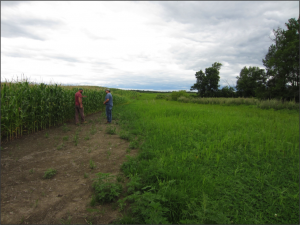
On a community level, there are also opportunities for knowledge exchange. As Ontario East ALUS continues to grow and become more established in the community, they plan to offer public tours showcasing ALUS projects. This will have the potential not only to spread information about the program itself, but also to raise public awareness about the ability of agriculture to provide ecological goods and services to the wider community.
Bridging Divides
While a primary purpose of ALUS relates to providing environmental benefits, the social benefits associated with the program are perhaps equally important. The greatest social benefit of the program may be its potential for connecting urban and rural residents. As Brendan Jacobs, Program Coordinator of Ontario East ALUS notes, “often, when you have an urban-rural divide, it’s sort of a pointing fingers kind of thing… and I think ALUS helps to bridge that gap, where you may have less of a divide and more of an understanding”. Through community outreach and conducting public tours of ALUS projects on farms, the program helps to foster greater understanding in communities, and to improve public perception of compatibilities between agricultural production and environmental sustainability. As noted by a farmer participating in the ALUS program, farmers may not be comfortable defending themselves against negative public perceptions regarding how agriculture relates to environmental concerns such as climate change and deforestation; however, participation in the ALUS program provides a tangible example of how agricultural stewardship practices can help combat climate change, improve water quality, and increase habitat and biodiversity.
ALUS also helps to bridge sectoral divides. As a community-driven program, ALUS is committed to bringing together people from various groups to form local Partnership Advisory Committees, including not only farmers, but also government representatives, the conservation community, and other non-governmental organizations. The establishment of a Partnership Advisory Committee is done in the early stages of launching ALUS in a new community. While initial tensions may exist in bringing these various sectors together, these tend to melt away quickly once people realize that the ALUS model allows them to work towards common goals of creating healthy landscapes that benefit the local environment, community, and economy.
Fostering Innovation
Tell someone, they’ll forget. Show someone, they’ll remember. Involve someone, they’ll understand. Enable someone, they’ll act.
— Modification of a proverb, cited as encompassing the ALUS model
Since its inception, ALUS has operated based on the understanding that the program must be community-developed and farmer-delivered, in order for it to be accepted within the community. The community-first principle is what makes ALUS effective, since “it hands power to the people that can help us” (Bryan Gilvesy). Further, since ALUS spreads by way of farmers and neighbours, rather than government agencies, it is more readily accepted within the local community.
While the ALUS model has been successful in Ontario East and elsewhere in Canada, there are government policies that impede their operations. As an environmental program, ALUS is subject to the same permits and regulations that any other individual or organization conducting work that has an environmental impact would be subject to. In some cases, the regulatory permits that ALUS must apply for are not really intended for the type of work that ALUS conducts. An example is the permit to take water, which is an Ontario provincial regulation. Although water is not technically “taken” from the ground when a wetland is constructed (rather, soil is removed from an existing wet area), ALUS is subject to the permit to take water process when creating wetland projects, which can add delays and additional costs to a project. While this is only one example of a government policy that hinders the work that ALUS does, the organization is subjected to similar processes in other parts of the country.
For Ontario East ALUS, the value of partnerships have been paramount in resolving issues related to government permits and regulations. The local Conservation Authorities are often able to provide technical expertise as an in-kind contribution to ALUS. Additionally, Ducks Unlimited, which has an existing relationship with the Ontario Ministry of the Environment and experience completing the permit to take water process, has taken on this process on ALUS’s behalf, as an in-kind contribution to the program.
Other legislation that has the potential to negatively affect the work that ALUS does is the Species at Risk Act. Under existing law, if a farmer or rancher undertakes a habitat improvement project on their property, and a species at risk subsequently begins using the property, the property can then become subject to habitat regulations that limit the uses of the land. This possibility can act as a disincentive for farmers who are considering participating in habitat improvement projects.
Nationally, ALUS is working with project partners to modify some of the legislation that places undue burdens on landowners. In the case of the Species at Risk Act, ALUS—along with its conservation partners—is trying to work out a “Safe Harbour” agreement, which would provide relief for landowners who create important habitat for species at risk on their property, such that they would not be subject to limitations on the use of their land as a result.
Resources Needed to Sustain the Project
As is the case with many non-profit organizations, long-term funding is a concern for both the ALUS program as a whole, and Ontario East ALUS. The current funding model is dependent on writing successful applications for funding grants, many of which must be reapplied for every year. Multi-year grants from the Ontario Trillium Foundation and the W. Garfield Weston Foundation were instrumental in launching the Ontario East ALUS three-year pilot program. As Ontario East ALUS continues to expand, however, they will require more funds for project implementation and annual payments to farmers, which may be outside the scope of many funding organizations, particularly those who follow an annual funding model. In the long-term, a more sustainable funding model for Ontario East ALUS may come from municipal tax revenue, which would involve reconceptualising how tax dollars are used for environmental and conservation purposes, and recognizing that since ecological goods and services arising from farmers’ actions are of public benefit, the community as a whole should contribute. For example, a portion of the municipal taxes paid by each household could go towards farmers and other landowners who retain forests and wetlands in their natural state, or who engage in practices that enhance the environment on their land.
Potted trees, before (left) and after planting (right). Photographs courtesy of Ontario East ALUS.
Constraints
In addition to the ongoing challenge to ensure that ALUS has adequate funding to maintain and expand their operations, there are other constraints that the program faces. Perhaps one of the most insidious of these is government policy that affects agricultural practices, which in turn has environmental consequences. For example, government incentives have encouraged increased production of corn in recent years, primarily to fulfill a demand for ethanol. As farmers grow more corn in response to higher prices, land is converted from idle agricultural land, native grassland, or other crops, into corn production. This has had repercussions for wildlife habitat; in Ontario, for example, a significant portion of the province’s grasslands were lost as a result of policies supporting increased corn production. This distortion of market relationships presents a challenge for ALUS.
Another ongoing consideration for ALUS is to maintain the positive perception of the program in the communities in which it operates. In Ontario East, farmers may be initially skeptical when they learn about the program. Concerns that initially arise are often related to government intervention (as discussed earlier), and the stability of program funds. If a farmer has concerns about the ability of ALUS to continue in the long-term, they may be understandably hesitant to put time, effort, and resources into establishing a project on their land. However, concerns regarding the ALUS model tend to decrease over time, and as Ontario East ALUS becomes more established in the community, and begins showcasing their projects to the public, these concerns will likely continue to decrease.
Successes and Challenges Overcome
When the Ontario East ALUS pilot project was launched in 2012, the goal was to become established in the community, and to implement between three and six projects within the first three years. The program has far surpassed this goal – by the end of 2015, they are on track to have roughly twenty-one projects in place on fourteen separate farms. The success of the program can likely be attributed to a combination of the program coordinator’s community outreach efforts through articles, presentations, and workshops, as well as information about the program spreading by word-of-mouth through participating farmers. The program’s close relationship with the local Conservation Authorities has also been helpful in establishing the program, since the two organizations have been working in the communities for decades, and have established trust and relationships with local landowners, which helped to facilitate ALUS’s acceptance in the community.
Future Plans
National Level
Over the next three years, ALUS plans to almost double the number of communities that they are active in, to twenty-three. While the program is currently a relatively minor environmental figure on the Canadian landscape, the planned growth over the next several years and beyond has the potential to greatly expand the program on the national scale.
Ontario East ALUS
Thanks in part to the success of the pilot program, Ontario East ALUS hopes to enrol between 60 and 100 acres per year in the program moving forward. This will involve building upon the momentum created so far, as well as increasing their public profile so that the program can become more of a self-sustaining initiative. As a relatively new organization, Ontario East ALUS is little known among the local farming community, aside from those farmers who are already participating in the program. In order to strengthen their profile, increased involvement with local farming networks will be beneficial. Many farming organizations operate in the Ontario East region, including local branches of the Ontario Federation of Agriculture, Beef Farmers of Ontario, and Grain Farmers of Ontario. Working with these organizations at the local association level could provide Ontario East ALUS with an opportunity to raise its profile among individual farming members, translating into a greater local awareness of ALUS and more participation among farmers.
While Ontario East ALUS is well-connected with environmental organizations, funding partners, and farmers, one area in which they would like to expand their network is with the local business community. One possibility may be to follow the model of the Norfolk County ALUS program, which has partnered with local wineries to develop a branding program. An ALUS sticker on a wine bottle indicates that a winery has a commitment to environmental conservation through their participation in the ALUS program. While ALUS does not receive funds directly from the sale of wine, the program helps to raise the profile of ALUS in the community. The Ontario East region is home to a multitude of farming-related businesses, including breweries, orchards, berry farms, and cheese-making factories. A branding program indicating that businesses support agro-ecological principles through supporting ALUS farms could be mutually beneficial for farmers, businesses, and the ALUS program.
One of the guiding principles of ALUS is that it is a farmer-delivered program, spread from farmer to farmer through ‘farmer liaisons’. During the pilot phase of Ontario East ALUS, the Program Coordinator has been active in increasing awareness of the
program; however, as the program continues to grow and become more established in the local community, a future direction will be to transition to the farmer-delivered model. As noted by Brendan Jacobs, “the way [the program is] best going to spread is neighbour to neighbour, farmer to farmer, and by organizations buying into the concept and spreading the word to their members”.
Relevance to Other Projects
That’s what’s exciting about what it is that we do. We find the leverage around the valuation of ecosystem services. Bryan Gilvesy
On a national scale, there are no other programs that provide annual payments to farmers for the ecological goods and services they provide. There are organizations that make one-time payments to farmers for environmental services, but no other organizations that pay farmers on an ongoing basis, as those services are produced. The ongoing nature of payments is key to the program; as Bryan Gilvesy notes, “it’s a production cycle, based annually on the growing season. That’s how we see it. No different than any other crop”. The work that ALUS does with private landowners on agricultural land helps to complement the work of other conservation organizations with different mandates, such as Ontario Nature and the Nature Conservancy of Canada.
In Eastern Ontario, the Raisin Region Conservation Authority and South Nation Conservation (through their Clean Water Program), as well as the Ontario Woodlot Association, work with private landowners to undertake activities such as planting trees and creating buffer strips on their land. Unlike ALUS, however, these programs do not provide annual payments to landowners. When community discussions were taking place to determine the feasibility of an ALUS program in Ontario East, there were initially some concerns regarding whether there would be too much overlap among the organizations. However, the relationships have turned out to be complementary. For example, if a project does not receive funding through the Clean Water Program, it may be eligible for funds through ALUS, or vice versa. Also, the organizations can pool funds to increase the budget of a project, leading to more significant ecological benefits. By working together and combining resources, these organizations have been able to increase their impact on the local environment, demonstrating a commitment to the ALUS principle of integrating with existing conservation programs.
Online Resources
Alternative Land Use Services: http://alus.ca/
Raisin – South Nation Source Protection: http://www.yourdrinkingwater.ca/
Raisin Region Conservation Authority: https://www.rrca.on.ca/
South Nation Conservation: http://www.nation.on.ca/
References
Alternative Land Use Services (ALUS). (2015). Alternative Land Use Services: Growing a healthier environment. Retrieved from: http://www.alus.ca/vision/.
Eastern Ontario Wardens Caucus (EOWC). (2007). A profile of eastern Ontario: Regional data set. Retrieved from: http://www.eowc.org/en/futuredirections/resources/Profile_Eastern_Ont-Regional_Data-Mar3107.pdf.





